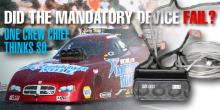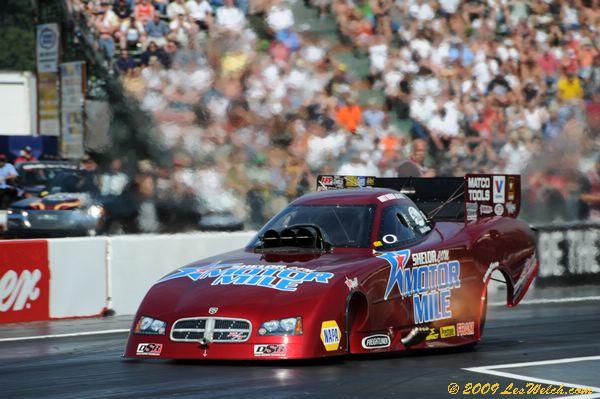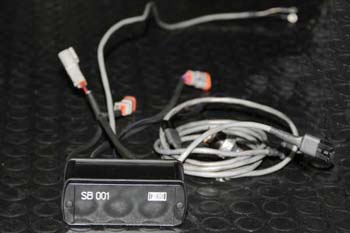DID THE SAFETY DEVICE FAIL?
Mon, 2009-07-20 16:28
Matt Hagan never made it past the staging lanes during the second qualifying session for the NHRA
 Northwest Nationals at Pacific Raceways on Friday because his parachutes suddenly dropped to the ground.
Northwest Nationals at Pacific Raceways on Friday because his parachutes suddenly dropped to the ground.
The next day, crew chief Tommy DeLago said the problem, the best he could tell, was centered in the automatic shut-off system mandated by the NHRA. DeLago is quick to admit the system definitely adds to the safety of the race car. He just doesn't know what else would have caused the chutes to deploy other than a fault with the system.
“It’s a spec system only available from one company,” explained Graham Light, NHRA Vice President of Competition. “It senses the manifold burst panel. When the panel opens up, it breaks the wire connection sending a signal to the device and it simultaneously deploys the parachutes and shuts the fuel and ignition off.”
Matt Hagan never made it past the staging lanes during the second qualifying session for the NHRA


Northwest Nationals at Pacific Raceways on Friday because his parachutes suddenly dropped to the ground.
The next day, crew chief Tommy DeLago said the problem, the best he could tell, was centered in the automatic shut-off system mandated by the NHRA. DeLago is quick to admit the system definitely adds to the safety of the race car. He just doesn't know what else would have caused the chutes to deploy other than a fault with the system.
“It’s a spec system only available from one company,” explained Graham Light, NHRA Vice President of Competition. “It senses the manifold burst panel. When the panel opens up, it breaks the wire connection sending a signal to the device and it simultaneously deploys the parachutes and shuts the fuel and ignition off.”
In Hagan's case, the engine was never started, so there was no burst panel to open which would have triggered the system.
“We don’t whether it is something within the box, because the manufacturer is not at the race. We will send that stuff back this week. There could be something within that system or the wiring in the actual electronic box. It could even be one bad sensor that’s supposed to monitor fire bottle pressure if he pulls the fire bottle. It could have ground out and activated the system.”
Maintenance of any system with wiring is critical to the working of the system. DeLago explained the team was doing the maintenance. But, were they doing enough?
“The maintenance is to check the wires,” explained DeLago. “You do a visual check to make sure nothing is getting pinched, cut or getting an abrasion from being routed along the chassis. All you can do is look over everything and make sure it’s good.
“These things [Top Fuel Funny Cars] are so violent that you could check it over at the shop and make just one run like we did on Friday and just the oscillation, vibrations and the amount of torsional forces that go through the chassis, it could happen between runs.
“You really have to have your maintenance program or it could bite you at any time.”
And, it did bite them. However, the one guy who spent time testing the system believes the system is virtually foolproof.
“That device did not malfunction,” Head said, even though he has not examined the components. “That’s just a crew chief throwing someone under the bus for their lack of attention to detail. It’s frustrating to hear someone say this malfunctioned because it is a worthwhile safety device.”
Head did a significant amount of testing on the unit with its creator Dave Lehey of Electro Motion.
This is not the first time a driver has seen a run go down the tubes because of a fault with the system, according to DeLago.
“It’s not as rare as everyone thinks. No one talks about it very much. I was talking to some of my friends over at the Kalittas that they had an issue during a run in Norwalk. I’m sure there are more issues than that, just nobody talks about it much.
“In the spirit of safety, I like the principle of it; the idea of it. I think it possibly may not have been tested enough in certain conditions and it needs certain improvements. I also think they [NHRA] will improve it. This is the first year of it and it still has to go through its evolution. I think that’s the direction the manufacturer will be going.”
Until the manufacturer tests the system being returned, neither Head or DeLago can really be certain what happened. DeLago's only recourse was to pull the system out of the race car and replace it with a new system.
“We took everything out of that system,” said DeLago. “Put everything on the shelf to send back. We put everything on the car brand new. This stuff had been maintenance and check. When we get something new, we don’t just put it on the car. We check every wire and make sure it was put together properly. NHRA mandates that we can’t even build our own harnesses for this system. It must be built by the manufacturer. We still have to check their work to make sure we aren’t getting something faulty.
“We put it in our cabinet and with last night’s situation all you can do is replace everything. That’s all you can do and what we did.”
In the future, the NHRA plans to increase the functions of the system in the interest of safety. Testing for the new functions have already begun.
“It has the capability to sense other things but is only mandated on the burst panel,” Light explained. “We’ve been experimenting with oil pan pressure and when the pressure gets up to a certain point, it will trigger the device. That’s not mandatory.
“We’ve been experimenting with transmitting a frequency just past the finish line when it senses that frequency and it sets off the device. It’s not mandatory.”
The latter has been tested on Jim Head’s car and one of John Force’s four team cars. Prudhomme’s car did the oil pan pressure testing.
 Northwest Nationals at Pacific Raceways on Friday because his parachutes suddenly dropped to the ground.
Northwest Nationals at Pacific Raceways on Friday because his parachutes suddenly dropped to the ground.The next day, crew chief Tommy DeLago said the problem, the best he could tell, was centered in the automatic shut-off system mandated by the NHRA. DeLago is quick to admit the system definitely adds to the safety of the race car. He just doesn't know what else would have caused the chutes to deploy other than a fault with the system.
“It’s a spec system only available from one company,” explained Graham Light, NHRA Vice President of Competition. “It senses the manifold burst panel. When the panel opens up, it breaks the wire connection sending a signal to the device and it simultaneously deploys the parachutes and shuts the fuel and ignition off.”
Matt Hagan never made it past the staging lanes during the second qualifying session for the NHRA

Matt Hagan lost a run on Friday evening when his parachute deployed
while in the staging lanes. Crew chief Tommy Delago believes the
evidence points towards a malfunction of the NHRA-mandated device. (Les Welch Photos)

The next day, crew chief Tommy DeLago said the problem, the best he could tell, was centered in the automatic shut-off system mandated by the NHRA. DeLago is quick to admit the system definitely adds to the safety of the race car. He just doesn't know what else would have caused the chutes to deploy other than a fault with the system.
“It’s a spec system only available from one company,” explained Graham Light, NHRA Vice President of Competition. “It senses the manifold burst panel. When the panel opens up, it breaks the wire connection sending a signal to the device and it simultaneously deploys the parachutes and shuts the fuel and ignition off.”
In Hagan's case, the engine was never started, so there was no burst panel to open which would have triggered the system.
“We don’t whether it is something within the box, because the manufacturer is not at the race. We will send that stuff back this week. There could be something within that system or the wiring in the actual electronic box. It could even be one bad sensor that’s supposed to monitor fire bottle pressure if he pulls the fire bottle. It could have ground out and activated the system.”
Maintenance of any system with wiring is critical to the working of the system. DeLago explained the team was doing the maintenance. But, were they doing enough?
“The maintenance is to check the wires,” explained DeLago. “You do a visual check to make sure nothing is getting pinched, cut or getting an abrasion from being routed along the chassis. All you can do is look over everything and make sure it’s good.
“These things [Top Fuel Funny Cars] are so violent that you could check it over at the shop and make just one run like we did on Friday and just the oscillation, vibrations and the amount of torsional forces that go through the chassis, it could happen between runs.
“You really have to have your maintenance program or it could bite you at any time.”
And, it did bite them. However, the one guy who spent time testing the system believes the system is virtually foolproof.
“That device did not malfunction,” Head said, even though he has not examined the components. “That’s just a crew chief throwing someone under the bus for their lack of attention to detail. It’s frustrating to hear someone say this malfunctioned because it is a worthwhile safety device.”
Head did a significant amount of testing on the unit with its creator Dave Lehey of Electro Motion.
This is not the first time a driver has seen a run go down the tubes because of a fault with the system, according to DeLago.
“It’s not as rare as everyone thinks. No one talks about it very much. I was talking to some of my friends over at the Kalittas that they had an issue during a run in Norwalk. I’m sure there are more issues than that, just nobody talks about it much.
“In the spirit of safety, I like the principle of it; the idea of it. I think it possibly may not have been tested enough in certain conditions and it needs certain improvements. I also think they [NHRA] will improve it. This is the first year of it and it still has to go through its evolution. I think that’s the direction the manufacturer will be going.”
Until the manufacturer tests the system being returned, neither Head or DeLago can really be certain what happened. DeLago's only recourse was to pull the system out of the race car and replace it with a new system.
“We took everything out of that system,” said DeLago. “Put everything on the shelf to send back. We put everything on the car brand new. This stuff had been maintenance and check. When we get something new, we don’t just put it on the car. We check every wire and make sure it was put together properly. NHRA mandates that we can’t even build our own harnesses for this system. It must be built by the manufacturer. We still have to check their work to make sure we aren’t getting something faulty.
“We put it in our cabinet and with last night’s situation all you can do is replace everything. That’s all you can do and what we did.”
In the future, the NHRA plans to increase the functions of the system in the interest of safety. Testing for the new functions have already begun.
“It has the capability to sense other things but is only mandated on the burst panel,” Light explained. “We’ve been experimenting with oil pan pressure and when the pressure gets up to a certain point, it will trigger the device. That’s not mandatory.
“We’ve been experimenting with transmitting a frequency just past the finish line when it senses that frequency and it sets off the device. It’s not mandatory.”
The latter has been tested on Jim Head’s car and one of John Force’s four team cars. Prudhomme’s car did the oil pan pressure testing.
Advertisement
Categories:


